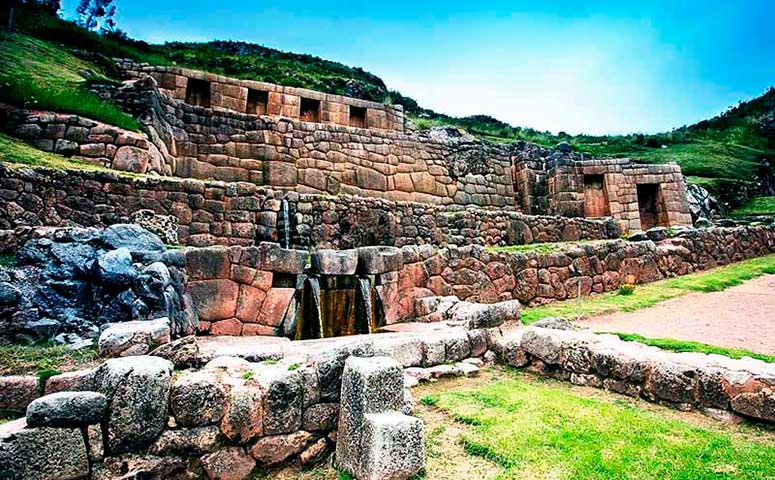
You don’t have to stray too far from the Historic Centre of Cusco to discover an archaeological park that reveals the grandeur of Inca stone architecture. It’s a magnificent testament to the ability of its builders to harmonise their monumental works with the surrounding landscape without losing its beauty.
On the contrary, the structures and walls blend seamlessly with their environment. When you see them, you’ll realise that these stones, fitted together without mortar, add a touch of charm to the natural scenery. This distinctive feature is particularly evident at Tambomachay, one of the pre-Hispanic sites within the Saqsaywaman archaeological park.
Awe. That’s what you’ll feel during your visit. That’s the effect the Andean legacy has on those seeing its buildings for the first time. Just read the accounts of the early Spanish chroniclers to notice their fascination with the civil and religious architecture they discovered in the valleys and mountains of the Inca territory.
Much time has passed since then, but the reaction remains the same, always the same. That’s why you feel excitement in front of the aqueducts, water fountains, and canal systems of Tambomachay, which, during the reign of the “Sons of the Sun,” would have served a ceremonial and religious purpose.
A water cult at one of the favourite stops for tourists visiting Cusco. Its proximity to the city (8 kilometres northwest and at 3,700 metres above sea level) makes it an ideal getaway for a first glimpse into Inca history and culture. There are no excuses. Tambomachay and the other attractions of Saqsaywaman await you.
Contents
Tambo or place of worship?
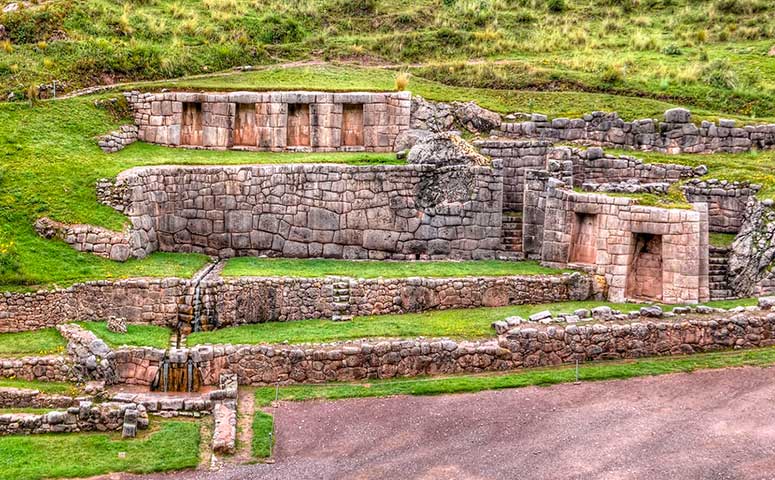
In a mountainous and strategic area on the right bank of the Huatanay River, there lies a tambo, a refuge, and a cave. At least, that’s what the etymology of the word Tambomachay suggests, derived from the Quechua words tampu (resting place) and machay (cave, refuge, or chosen dwelling).
Tampu or tambos, as they are known in Spanish, were inns or resting stations that provided accommodation and supplies to pre-Hispanic travellers. Along the extensive network of footpaths created by the Incas, many of these stops existed, often serving more than one purpose.
That would be the case for Tambomachay, because despite its name—translated as “resting place,” although you could also say “in the chosen dwelling“—there is no absolute certainty about the role it played when Cusco was the political, cultural, and religious epicentre of the Andes.
The most accepted theory suggests that this sector of the Saqsaywaman archaeological park was a sacred space linked to the worship of water and the deities associated with this element. In Andean cosmovision, mountains, the earth, and the sun are alive, and various rituals were performed in their honour.
But if the archaeological site was a religious centre, why does its name include the word “tambo”? It is believed that travellers had to purify themselves in the waters of Tambomachay before entering Cusco. This ceremonial “requirement” may have turned the area into a resting and lodging place.
Relationship with water
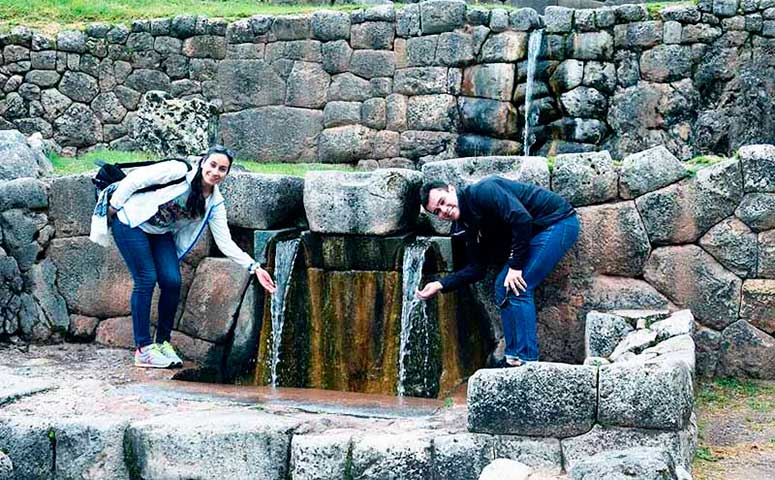
Water that nourishes the fields. Water that quenches the thirst of Mother Earth and humanity; so how can we not revere and respect it? How can we not eagerly await the rains to ensure our crops thrive and the rivers swell to nourish the valleys? Yes, how can we be ungrateful to it when, without water, there is no life?
From this logic and historical perspective, it’s not unreasonable to argue that the terraces, channels, fountains, and carved stone baths of Tambomachay were associated with purification rituals and reverence for yaku (water in Quechua) and other Andean deities.
Today, in various towns across Peru, celebrations related to the arrival of water in the fields occur, through channels and irrigation ditches. This shows that, despite the so-called eradication of idolatry, the cosmology of ancient civilizations continues to resonate in the hearts of their descendants.
But let’s not stray too far from Tambomachay… at least not just yet. There will be a time when you can participate in a Yaku Raymi (Festival of Water in Spanish) in the Peruvian highlands. For now, you are on the outskirts of the “navel of the world,” in an impressive archaeological park of the Andean civilization.
And within that park, from where you can see the urban layout of modern Cusco, there are springs that still flow. Their existence has led archaeologists to believe that this “chosen dwelling” was a place where the Inca elite performed purification rituals before returning to the capital of their empire.
A day in the park
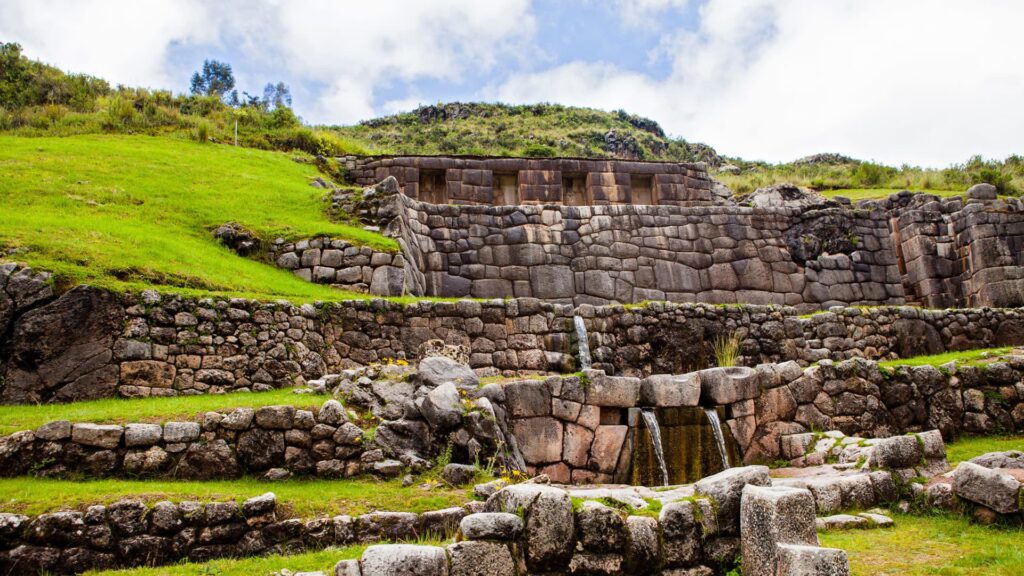
Before heading to your destination, it’s essential to know this information. Tambomachay is one of the 96 historical zones within the Saqsaywaman archaeological park. Declared a National Cultural Heritage site in 2006, it was the most important place after the city of Cusco during the Inca period.
The park’s origins date back to the reign of Pachacútec, the ninth sapa inca. Due to its value and size (covering nearly 3,000 hectares), it’s important to explore it at a leisurely pace. This way, you can also visit other significant sites such as the Baluartes, Muyuqmarca, Rodadero, Chinkana, and Q’enqo.
As for timing, there’s no issue. The visiting hours are Monday to Sunday from 7:00 a.m. to 5:30 p.m. Feel free to spend the whole day exploring the main areas. If that’s not possible, try to visit early when there are fewer tourists.
Beyond the timing, the key is to include this destination in your holiday plans in Peru. Don’t worry about the cost. The Saqsaywaman archaeological park, and by extension Tambomachay, is included in both types of the Cusco Tourist Ticket.
Prices vary depending on the visitor’s origin. The full ticket costs 70 soles for Peruvians and 130 for foreigners, while the partial ticket (Circuit 1) costs 40 soles for Peruvians and 70 for foreigners. Students pay a different rate for the full tickets.
How to get to Tambomachay?
Due to its proximity to the Historic Centre of Cusco, getting to Tambomachay is straightforward and varied. If you enjoy walking or cycling, challenge yourself with the 8-kilometre distance that separates the city from your destination.
If your goal is to save money or experience public transport, hop on a combi that will take you to the archaeological site. These minibuses run from various locations in the city. Keep in mind that the vehicles are not modern and can be quite uncomfortable.
Another option is to take a taxi or hire the services of a tour operator. Many itineraries include visits to the Historic Centre and the archaeological park. Both options are the most comfortable and safe. Ultimately, however you choose to go, you’ll enjoy your time among the Inca stones.
- Walking or cycling: a challenge and also a chance to get some exercise. If you’re acclimatised to the altitude and enjoy steep paths, this option is for you. Travel time: approximately one hour.
- By public transport: the combis will drop you off at Cristo Blanco. From there, you’ll need to walk to the entrance of Saqsaywaman (10 minutes). The companies Cristo Blanco and El Huerto will take you to your destination. Travel time: about 30 minutes.
- By taxi: you can catch a vehicle from anywhere in the city to take you to the archaeological site. Be sure to negotiate the fare before getting in. Choose your taxi carefully.
- On a tour with a local operator: Cusco agencies offer various itineraries to visit Tambomachay and the other archaeological sites of Saqsaywaman. Check the service costs and choose the company that you trust the most.
Travel recommendations
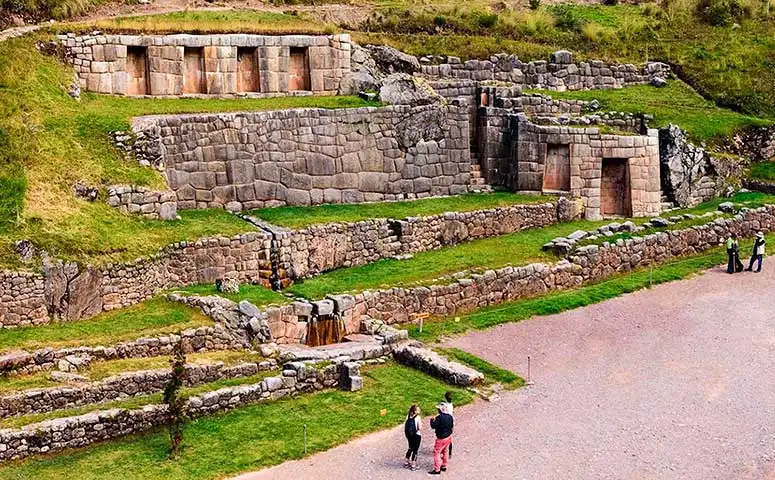
- Plan your visit in advance. Being informed is always a great travel strategy.
- Don’t underestimate the weather. Even if the day is sunny, always bring a warm layer and a waterproof jacket.
- Solar radiation is no joke. Don’t forget to apply sunscreen and wear a cap or hat. UV-protective clothing is also a good option.
- If you’re visiting Tambomachay on your first or second day in Cusco, avoid excessive physical exertion. Your body won’t be fully acclimatised to the altitude yet.
- Stay hydrated. Drinking plenty of fluids helps counteract the symptoms of altitude sickness.
- Respect the archaeological site. Do not litter or handle the stones.
- Be mindful of local customs. Avoid behaviours that may annoy the locals.
- Wear comfortable and suitable footwear for walking, especially if you plan to explore Tambomachay and the surrounding sites for several hours.






